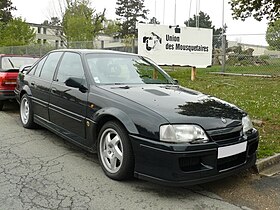Lotus Carlton
| Lotus Carlton | |
|---|---|
 |
|
| Overview | |
| Manufacturer | Lotus (General Motors) |
| Also called | Opel Lotus Omega Vauxhall Lotus Carlton |
| Production | 1990–1992 |
| Assembly | United Kingdom: Hethel, Norfolk |
| Body and chassis | |
| Class | Sports saloon |
| Body style | 4-door saloon |
| Layout | FR layout |
| Platform | V-body |
| Related |
Opel Omega A Holden Commodore VN Holden Commodore VP |
| Powertrain | |
| Engine | 3.6 L C36GET I6 TT |
| Transmission | 6-speed ZF S6-40 manual |
| Chronology | |
| Predecessor | Lotus Cortina |
Opel Omega A Holden Commodore VN
The Lotus Carlton (other names include Vauxhall Lotus Carlton, Lotus Omega and Opel Lotus Omega) is a Vauxhall Carlton/Opel Omega A saloon upgraded by Lotus to be a 177 mph (285 km/h) sports saloon with acceleration to equal contemporary supercars. Like all Lotus vehicles, it was given a type designation—Type 104 in this case. The external differences were minimal with the addition of a rear spoiler, vents on the bonnet, Lotus badges on the front wings and bootlid, a bodykit and considerably wider wheel arches distinguishing it from a standard Carlton/Omega. The car was only sold in one colour, a shade called Imperial Green, a very dark green that in anything but direct light appears black.
Performance modifications started with an upgraded engine, which was enhanced by Lotus from the standard Opel 2969 cc 24v straight six unit (used in the GSi). The engine was enlarged to a capacity of 3615 cc. Lotus then added twin Garrett T25 turbochargers, which provide up to 0.7 bar of boost from about 1500 rpm. The original distributor ignition system of the engine was replaced with a three-coil wasted spark system. The distributor drive was re-purposed as a water pump drive for the water-air intercooler circuit. The intercooler itself is manufactured by Behr and is capable of reducing the temperature of the compressed charge from 120 °C to 60 °C.
In addition to fitting two turbochargers and an intercooler system, Lotus directed a number of engineering changes to the engine so that it would perform reliably with the higher power output. To cope with the higher cylinder pressures (about 95 bar), the external webbing on the engine block was reinforced. The crankshaft was replaced as well; early development crankshafts were machined from billet steel in Italy, but the production units were forged by Opel and sent to Maschinenfabrik Alfing Kessler for machining. The cylinder head was left mostly the same as the 24-valve head from the Opel Omega, although the combustion chamber was milled to reduce the static compression ratio to 8.2:1 (from 10.0:1). The engine is fitted with forged slipper pistons produced by Mahle. Piston connecting rods were replaced with new units made to an original Lotus design.
...
Wikipedia
